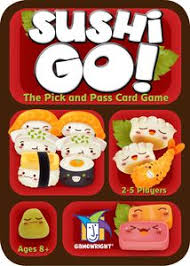
written by David Steffen
Sushi Go is a competitive point-scoring strategy game, published in 2013 by Gamewright. The game is based around grabbing sushi as it whirls by and making yourself an excellent three-course meal.
Everyone starts with a hand of cards. You all pick one card, lay it face down on the table. When you’re all ready, you flip the card face up so everyone can see it and pass your entire hand of remaining cards to the left, and this repeats until all of the cards are depleted. That constitutes one round. A full game is three rounds, at the end of which whoever has the most points win the game.
Nigiri are the easiest cards to score; they’re each worth 1, 2, or 3 points flat. If you get three sashimi you get 10 points for the group, but if you have only one or two, they’re worth nothing. Wasabi is worth nothing by itself, but if you play one, your next nigiri is worth triple its face value. Pudding, the dessert, aren’t scored at the end of the round like all of the other cards, but is all saved for the end, at which point the player with the most pudding gets 6 points and the one with the least (including 0) loses 6 points. Chopsticks, once played, can be used for a future round to pick two cards out of the hand instead of one.
It’s a fast-paced game, and can be very quiet as each of you silently picks a card and passes for the round. At the beginning, when you have the most cards to pick from, you have a very incomplete view of the cards in play, so you don’t know if there are enough sashimi to actually get a full set. As you play, you can see how everyone else’s strategies are forming and you can pick the method to score the most yourself or block someone else’s strategy.
The game says that it’s for ages 8+, but my 5-year-old loves the game and wants to play it every night. They’ve got all of the scoring systems memorized and understands the strategies to playing each of them (even if they don’t always make the shrewdest decisions. The game can be played by 2-5 players, and is a great way to pass the time.
Audience
All ages who are old enough to be ready for this type of strategy. Like I said, my 5 year old plays it very well and loves every minute.
Challenge
Can be quite challenging, depending on how competitive your fellow players are. The most ambitious strategies are also designed to be a gamble, so you might play sashimis only to find that there are only 2 in the set of hands being passed around. If you play a wasabi early in the hopes of seeing a 3-point squid nigiri, you might only find 1-point egg nigiri. So there’s a strategic gambling to the whole game setup.
Session Time
You can play a full game in maybe 10-15 minutes, so reasonably quick, if not as quick as some other games.
Replayability
Lots of replayability, your strategies might or might not be rigid, but the variations of the card combinations and the other player’s strategies serve to keep it fresh.
Originality
I haven’t played a game similar to this, fun and original.
Overall
A very fun and fast-paced strategy scoring game where chance plays a big enough factor that the best strategist isn’t going to just walk away with a win easily. Suitable for people of all ages, and is a lot of fun, (and inspired us to try eating sushi for the first time).
